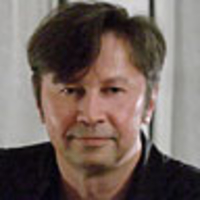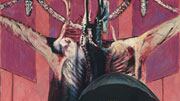
Francis Bacon’s daring yet disturbing portrayals of friends and lovers and his imaginative interpretations of historical paintings, photographs, and films have long been celebrated. Now the controversial self-taught British artist is the subject of a grand, 100th-year birthday retrospective at New York’s Metropolitan Museum of Art.
The exhibition, which began at Tate Britain last fall and traveled to Madrid’s Museo Nacional del Prado earlier this year, was originally organized around such central themes as animal, crucifixion, and crisis. However, at the Met, curators Gary Tinterow and Anne Strauss stage a chronological viewing for Francis Bacon: A Centenary Retrospective that takes the viewer through the most significant stages of Bacon’s development as an artist—from his early success in the ’40s and portraits of people in the ’60s and ’70s to self-portraits and landscapes in his final decade. The paintings, ephemera, wall texts, and audio tour construct a story of an obsessive, gifted genius who lived for love and art until he took his last breath on April 28, 1992.
Click Image Below to View Our Gallery
ADVERTISEMENT

The show opens with Three Studies for Figures at the Base of a Crucifixion (1944), a triptych of distorted, repellent figures—defiantly perched on tabletops and a patch of grass—that are all mouths and muscle. Of equal importance is Painting (1946), which New York’s Museum of Modern Art acquired two years after it was made. It features a dark, anguished figure surrounded by a lexicon of Bacon’s symbols: butchered meat, silhouetted window shades, black umbrellas, and tubular rails that echo his modernist furniture designs. An accident that developed from a sequence of false starts, Painting is shown in an intimate room with several Head series paintings that were exhibited in Bacon’s first solo show at London’s Hanover Gallery in 1949.
Head VI (1949), which is the cover image of the Met’s catalog, is a horrific portrait of a screaming, robed man that may have been the first work in Bacon’s series of pope paintings, made after Portrait of Pope Innocent X (1650) by the 17th-century Spanish painter Diego Velázquez. Working from a reproduction, Bacon would eventually paint more than 40 versions of the Velázquez masterpiece; although he later said none were as good as the original. Today, however, Bacon’s pope paintings are highly coveted.
The paintings, ephemera, wall texts, and audio tour construct a story of an obsessive, gifted genius who lived for love and art.
Expressive paintings of people and animals in motion, from the ’40s and ’50s, such as Study of a Baboon (1953), a primate that appears to be both in and out of its cage, are featured in the third and fourth galleries, alongside the pope paintings and leading into a room of four of the seven known paintings from the Men in Blue series (1953-55). Study for a Portrait (1953), from the Hamburger Kunsthalle Collection, is the most dynamic, simultaneously depicting a suited man in his bed and at his desk—a figure of authority considered to be a portrayal of Bacon’s tumultuous lover Peter Lacy, an ex-RAF pilot.
The Men in Blue series utilizes Bacon’s favored technique of thick, vertical, curtain-like lines, which he referred to as shuttering, to obscure the figure and ground and veil what might be considered any lack of painterly finesse. Bacon also chose to present all of his works behind glass, in gilded frames, to lend a level of importance to the work. The glass establishes a distance between the painting and the viewer, while disturbingly causing one to see his own reflection in it.
In 1961, after Bacon’s move to 7 Reece Mews in London, a new, spare aesthetic evolved, which placed a lone figure or pair of figures on a painted background of one or two colors. Paralytic Child Walking on All Fours (from Muybridge), from that year, is a fine example of this stylistic shift. Based on a 19th-century Eadweard Muybridge photograph, it focuses on a child walking like an animal in a sparse plane, a vision that expressed Bacon’s existentialist belief that we are the same as animals, living life without a predetermined nature.
The following year, Bacon painted Three Studies for a Crucifixion (1962), the first triptych he had made in 20 years, which put him back on the path to paint many more. The riveting painting—which symbolically captures Hitler and Himmler pushing people into the gas chamber; a contorted, bullet-ridden body on a bed; and Christ as an irreverent slab of beef, sliding down the cross—was made for his 1962 retrospective at the Tate Gallery and offered a powerful response to the American abstract painters, who dominated the international art scene at the time and worked on a similarly grand scale.
The ’60s and ’70s are arguably Bacon’s best years. He enlisted Vogue photographer John Deakin to photograph his coarse, creative group of friends, preferring to paint them from pictures, as he saw fit, in the solitude of his messy studio. Bacon crumpled and folded the photos to get new, distorted perspectives on the models’ faces, perhaps seeing them in their drunken states at the bar.
There are portraits of Henrietta Moraes, Isabel Rawsthorne, and George Dyer in the show. Moraes, a lover of Lucian Freud, is splayed nude on a bed; Rawsthorne, a painter who had also modeled for Giacometti and Picasso, stands in a surreal vision of a Soho street; and Dyer, Bacon’s lover, rides a bike on a suspended rail. He was the inspiration for some of Bacon’s best paintings of the ’60s, including Two Studies for a Portrait of George Dyer (1968), which places two views of the dapper dude—one twistingly evil and the other vacuous—hovering around an ashtray, overflowing with cigarette butts.
Bacon rivals Picasso in the way he represents the body, particularly the face. He defines the model’s nature, which is most often dark, through a combination of elegant marks. Everything is in motion, and the triptych panels often construct a narrative, like the frames of a film do. In the ’70s he made even more triptychs of Dyer, but now to memorialize his suicidal overdose, which came on the eve of Bacon’s retrospective at the Grand Palais in Paris. Triptych— In Memory of George Dyer (1971) dramatically mixes Dyer’s death in a Paris hotel with a passage from T.S. Eliot’s poem The Waste Land, while Triptych— August 1972 (1972) shows his former companion dissolving into pools of pink fluid.
The remainder of the paintings in the show focus on Bacon’s small but powerful portraits; a few landscapes, in particular Blood on Pavement (1988), which throws stark reality into a painting that mocks a Mark Rothko; a Portrait of John Edwards (1988), Bacon’s lover since 1976, seated on a chair in a position that’s reminiscent of Dyer’s portraits; and a final self-portrait, Triptych (1991), which juxtaposes two coupling figures, based on a Muybridge photograph, surrounded by two truncated bodies, one with the head of a Brazilian race-car driver and the other with the head of Bacon.
Beyond his lifetime of work, Bacon left a studio full of ephemera: pictures of wrestlers, boxers, and baseball players, torn from books and magazines; Deakin’s photographs, smudged with Bacon’s paint-stained fingerprints; fragments of medical journals; and sketches and handwritten notes on scraps. As enchanting as the art that fills the surrounding galleries, it gives the viewer insight into the simple origins of some of the most psychological paintings ever made.
Paul Laster is the editor of Artkrush.com, a contributing editor at Flavorpill.com and Art Asia Pacific, and a contributing writer at Time Out New York and Art in America.





